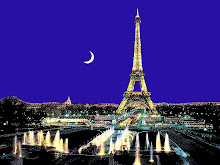Something very small
Labels :
Paris 10,
Paris architecture,
Smallest house in Paris
Returning to Paris with my posts, I will start in a very modest way: One single and small photo of what is the smallest building in Paris - with its own street number. The address is 39, rue de Château-d’Eau, 10th arrdt. The building is about 1,2 m wide and 5 m high (3,3 x 16 ft).
It seems that this was originally a narrow opening leading to another street, but after some heritage quarrel, someone decided to obstruct the passage. There used to be a tiny shop, obviously closed, but someone seems to live behind the only window.
The “narrow” sign in front of the building was there for some road works, but I feel that it was at its right place!
The street name (the Water Tower Street) could possibly interest especially one blogger who has a passion for nice and decorated water towers. I’m sorry hpy, there is no water tower around. It seems that there used to be some kind of fountain.
It seems that this was originally a narrow opening leading to another street, but after some heritage quarrel, someone decided to obstruct the passage. There used to be a tiny shop, obviously closed, but someone seems to live behind the only window.
The “narrow” sign in front of the building was there for some road works, but I feel that it was at its right place!
The street name (the Water Tower Street) could possibly interest especially one blogger who has a passion for nice and decorated water towers. I’m sorry hpy, there is no water tower around. It seems that there used to be some kind of fountain.







 All nice things come unfortunately to an end; time to go back to Paris – of course also quite nice!
All nice things come unfortunately to an end; time to go back to Paris – of course also quite nice!





 Once more, if you wish to see the photos in full, please go to my
Once more, if you wish to see the photos in full, please go to my 
 The islands which are the easiest to reach when you are based in Puno (arrival point of the train from Cusco) are the famous Uros artificial islands made of floating reeds. They are populated by some 2000 people - meaning a lot of intermarriages -, living on fishing, bird hunting and eggs and today on tourism. As the bottom of the islands decay, they put new reeds on top, but after some ten years they have to construct a new island. Their “houses” are very simple (see one of the photos) and there are no commodities… however some of them have invested in solar panels and can have some temporary access to light, television…
The islands which are the easiest to reach when you are based in Puno (arrival point of the train from Cusco) are the famous Uros artificial islands made of floating reeds. They are populated by some 2000 people - meaning a lot of intermarriages -, living on fishing, bird hunting and eggs and today on tourism. As the bottom of the islands decay, they put new reeds on top, but after some ten years they have to construct a new island. Their “houses” are very simple (see one of the photos) and there are no commodities… however some of them have invested in solar panels and can have some temporary access to light, television…












 … and tomorrow I plan to talk about the lake!
… and tomorrow I plan to talk about the lake!



 On the Peruvian menus you will generally be offered excellent soups, trout as dominating fish, llamas, alpaca, “cuy” (guinea pig) or chicken as meat, “papas” (potatoes; some 600 varieties), corn (also in a lot of varieties and colours), a magnitude of wonderful vegetables – all this can be rather spicy -, nice cakes (cucadas, churros, champus), fruits of all kinds, very good beers and some more than acceptable local wines….
On the Peruvian menus you will generally be offered excellent soups, trout as dominating fish, llamas, alpaca, “cuy” (guinea pig) or chicken as meat, “papas” (potatoes; some 600 varieties), corn (also in a lot of varieties and colours), a magnitude of wonderful vegetables – all this can be rather spicy -, nice cakes (cucadas, churros, champus), fruits of all kinds, very good beers and some more than acceptable local wines…. 





 To see these photos better, I would suggest you go again to my
To see these photos better, I would suggest you go again to my 





 But, Cusco is of course the place from where you visit Machu Picchu and the Sacred Valley. These will be the following episodes.
But, Cusco is of course the place from where you visit Machu Picchu and the Sacred Valley. These will be the following episodes.











